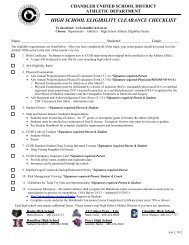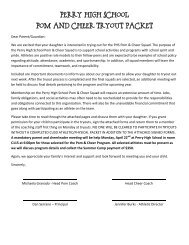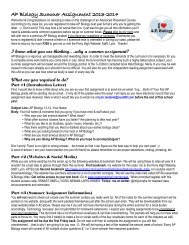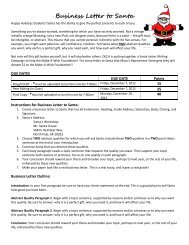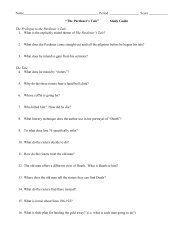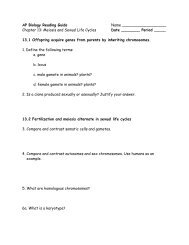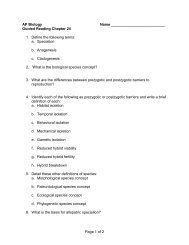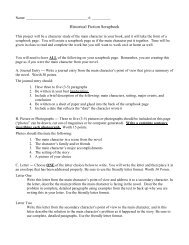Lab: Karyotypes and Genetic Disorders
Lab: Karyotypes and Genetic Disorders
Lab: Karyotypes and Genetic Disorders
Create successful ePaper yourself
Turn your PDF publications into a flip-book with our unique Google optimized e-Paper software.
<strong>Lab</strong>: <strong>Karyotypes</strong> <strong>and</strong> <strong>Genetic</strong> <strong>Disorders</strong><br />
Purpose:<br />
1. To be able to assemble a karyotype of an organism properly for analysis<br />
2. To relate the significance of karyotypes to chromosomal disorders <strong>and</strong> genetics found in<br />
populations.<br />
Prelab Questions:<br />
1. What is a karyotype<br />
2. Describe how a karyotype is laid out for analysis by geneticists.<br />
3. What are the two types of chromosomes found in a karyotype<br />
Procedures:<br />
Part I: Normal <strong>Karyotypes</strong><br />
1. Analyze the karyotypes <strong>and</strong> identify the sex of each individual in your lab book. Write<br />
down differences you observe between karyotype I <strong>and</strong> karyotype II.<br />
Normal Karyotype I: Sex: ______ Normal Karyotype II: Sex: ______<br />
Part II: Abnormal <strong>Karyotypes</strong><br />
1. Obtain a chromosome spread from teacher. Record patient number on the karyotype sheet<br />
provided.<br />
2. Carefully cut out each chromosome from the chromosome spread <strong>and</strong> arrange chromosomes in<br />
homologous pairs.<br />
a. The members of each pair will be the same length <strong>and</strong> will have the centromere in the<br />
same location. Use the ruler to help measure the length of the chromosome <strong>and</strong> the<br />
position of the centromere.<br />
b. The b<strong>and</strong>ing patterns may also help you pair up the homologous chromosomes.<br />
3. Arrange each homologous pair according to their length, from largest to smallest. Keep an eye<br />
out for the sex chromosomes (XX or XY). The Y chromosome will be small <strong>and</strong> the X<br />
chromosome will be different from the others! Do not glue them down until you have figured<br />
out what the X <strong>and</strong> Y chromosomes look like!
4. Glue each homologous pair to the sheet of paper titled “Human Karyotyping Form.”<br />
c. Place the pairs in order, with the longest pair first, labeled as position 1 <strong>and</strong> the shortest<br />
pair at the end, labeled as position 22.<br />
d. The sex chromosomes should be labeled as position 23 <strong>and</strong> be at the end of your<br />
karyotype. See image in Part I for the layout of a karyotype of a normal individual.<br />
5. Analyze the karyotype.<br />
e. Determine the gender of the individual, how many chromosomes are in the karyotype.<br />
Identify on the karyotype form.<br />
f. Determine whether or not the karyotype shows an abnormality. Identify <strong>and</strong> record on<br />
the karyotype. If abnormal, identify the abnormality according to the genetic disorders<br />
listed below.<br />
6. On a separate sheet of paper, create a brochure of the disorder for the parents of a child that<br />
may have this disorder. You may use a computer if you choose.<br />
g. Must include description of disorder, support information, <strong>and</strong> references.<br />
<strong>Genetic</strong> <strong>Disorders</strong> Reference Chart<br />
Down’s Syndrome Trisomy 21<br />
Patau Syndrome Trisomy 13<br />
Edward’s Syndrome Trisomy 18<br />
Klinefelter’s Syndrome XXY sex chromosomes<br />
Turner’s Syndrome<br />
Cri Du Chat Syndrome<br />
X sex chromosome only<br />
One chromosome 5 will have a shortened<br />
chromatid<br />
Postlab Analysis:<br />
1. The X chromosome closely resembles many of the other chromosomes. How were you able to<br />
identify it from the other chromosomes<br />
2. If your karyotype indicated a genetic abnormality, what are the characteristics associated with<br />
that abnormality Is it fatal<br />
3. What are the diploid (2n) <strong>and</strong> haploid (n) number of chromosomes for this organism<br />
4. During what division process (mitosis or meiosis) are cells photographed for karyotypes<br />
5. During which phase of that cycle are cells photographed for karyotype<br />
6. Why are karyotypes important tools for geneticists<br />
7. Do organisms with chromosomal disorders survive in a population Why do you think this



